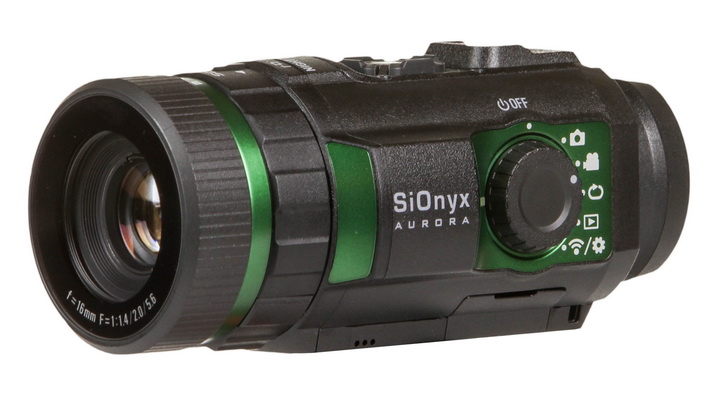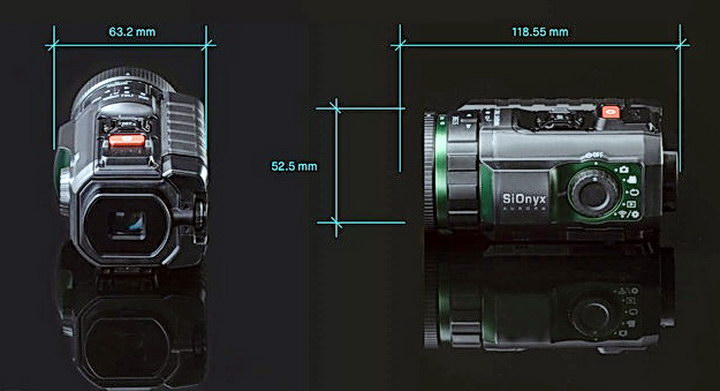SiOnyx, maker of low-light level image sensors, formally launched its first consumer product on July 24th at the Outdoor Retail Expo in Denver. The Aurora is a low-light level camera for consumer and professional applications and uses, of course, a SiOnyx imaging sensor plus an OLED microdisplay as the NTE viewfinder of the camera.

This was not exactly a surprise announcement because SiOnyx had placed the Aurora on Kickstarter in April and the camera has its own YouTube channel. On Kickstarter, they funded their initially planned $50,000 in four hours and went on to raise a total of $304,820 from 624 backers.
 The Aurora low-light level camera from SiOnyx. (Credit: SiOnyx)
The Aurora low-light level camera from SiOnyx. (Credit: SiOnyx)
On July 19th I met with Stephen Saylor. President & CEO of SiOnyx, and Dr. James Carey, Principal Scientist & Co-Founder of SiOnyx, at the SoHo Grand hotel in New York. I was told they chose that hotel in part because it has particularly good blackout curtains that allows them to demonstrate the Aurora in near-total darkness. The company was founded in 2006 to exploit technology developed at Harvard University by Dr. Carey and Professor Eric Mazur, the other co-founder of SiOnyx. Before the Aurora camera, which is the company’s first consumer product, they focused on low-light-level sensors for military, aerospace and related applications.
Low-light-level image sensor used in the Aurora camera from SiOnyx (Credit: SiOnyx, with measurement added by M. Brennesholtz)
The sensor in the camera has a 720p (1280 x 720) active area on a 1” diagonal CMOS chip. It will display and record HD video at either 60fps or 30fps. According to Mr. Saylor, for active tasks, such as walking at night using the Aurora as a vision aid, 60fps video is essential. On the other hand, 30fps video has double the exposure time for each image, increasing the camera’s light sensitivity in low-light conditions. For still images, the system can use still longer exposure times, further increasing its sensitivity.
While Dr. Carey was at Harvard University, he worked with Professor Mazur to develop a practical process to manufacture what is commonly called “Black Silicon.” This process produces a gradient index coating on the silicon surface, reducing its reflectivity and increases its absorption of visible and infra-red light. This higher light absorption by the sensor is responsible for part of the low-light sensitivity of the camera. The relatively large size of the sensor is another factor in its sensitivity, as is the low f/# of the imaging lens used, f/1.4. Finally, I am sure there are design details in the CMOS sensor the company isn’t willing to disclose that add to its sensitivity. Dr. Carey is a named inventor on 12 U.S. and international patents and author of 20 papers, so I suspect digging deeper would reveal some of these details. The sensor of the Aurora is made for SiOnyx by TSMC, who is a licensee of the company’s black silicon process.
The NTE imager in the Aurora viewfinder is a 0.39” diagonal OLED microdisplay with a resolution of 1024 x RGB x 768. It is made for them by an Asian OLED OEM manufacturer, although they declined to identify who.
 Two Photos of Meko’s Matt Brennesholtz taken in a darkened room. Left: taken with the SiOnyx Aurora camera. Right: taken with a Canon S120 camera. (Credit: S. Saylor and M. Brennesholtz)
Two Photos of Meko’s Matt Brennesholtz taken in a darkened room. Left: taken with the SiOnyx Aurora camera. Right: taken with a Canon S120 camera. (Credit: S. Saylor and M. Brennesholtz)
The camera did do well in the low light levels available in the SoHo Grand, as shown in the image. The left image was taken with the Aurora camera at a shutter speed of 1/20 of a second. The (barely visible) right image was taken with a Canon S-120 camera with a shutter speed of 1/8 second. With its low f/# (f/1.8) and relatively large image sensor (1/1.7” or 0.59”) this camera is better than most point-and-shoot cameras in low light levels. If you adjust the gamma of the image to bring out the details in the dark area (i.e. the whole S-120 image) you can see that it actually a picture of me, albeit much noisier than the Aurora image.
 SiOnyx posted a video of a visit to a Disney theme park shot entirely with an Aurora camera. (Credit: SiOnyx)
SiOnyx posted a video of a visit to a Disney theme park shot entirely with an Aurora camera. (Credit: SiOnyx)
The camera performs well under all light conditions and SiOnyx says it can be used as a general purpose camera, not just as a low-light camera. Unlike some night vision systems, the camera can produce full color images and can operate without danger of damaging the sensor in bright sunlight. Unfortunately, the camera lacks several features taken for granted for a stand-alone camera in this price range, including a multi-megapixel sensor, auto-focus and a zoom lens. The camera has Wi-Fi and USB interfaces, built in GPS and uses a micro-SD card for storage. The interchangeable 1025mAh 3.6V Li-Ion battery (NP-50 type) is said to be good for ~ 2 hours continuous recording at 60 fps, with Wi-Fi and GPS enabled. By turning these functions off, the system is actually good for much longer times, Saylor told me. The viewfinder is removable and, when removed, gives access to the battery and micro-SD card. The Kickstarter project page says that some of the Kickstarter money will be used to develop additional modules, such as long-range Wi-Fi, that will attach to the camera in the viewfinder location. Both iOS and Android apps are available for the camera.
The camera optical system has an IR filter in it. This is in the optical path, blocking the infra-red light, for day and twilight recording in full color. It can be moved out of the path for the lowest light level sensitivity where the ambient IR light is also allowed to reach the sensor, along with the red, green and blue visible light. This will provide a full color image, although the colors may not be as true as when the filter is in the path.
The camera is rated IP-67 for dust and water protection. On it’s YouTube Channel, the company has posted a video showing how the camera was used to record a family’s visit to a Disney theme park. Some of the images in the Disney theme park video were shot underwater with this camera.
However, most experts recommend an IP67 system be treated as a “water resistant” system, not “waterproof” like an IP68 system. While IP67 devices are supposed to be water resistant to 1M (3.3 feet) depth for up to 30 minutes in pure water, pool water with its chemicals or salt water at the beach may still damage an IP67 system.
Still, it is very nice to know a casual splash or dropping the system in the sand shouldn’t damage it. One application of the camera is night boating, where a night vision system simplifies harbor navigation and docking. Another application is hunting, both day and night. The Aurora has a mechanical shock trigger for video recording. This is used when the camera is rail-mounted on a rifle. The mechanical shock of the rifle firing triggers the video recording for 30 seconds. This is a pre-trigger system so 15 seconds before and 15 seconds after the rifle firing are recorded.
 The Aurora low-light level camera from SiOnyx is relatively compact. (Credit: SiOnyx)
The Aurora low-light level camera from SiOnyx is relatively compact. (Credit: SiOnyx)
I was told the camera has many applications besides consumer applications. The company has seen interest from harbor masters, the Coast Guard, fire, police etc. interested in its day/night/IR detection abilities.
Blaze, a wholly-owned subsidiary of eMagin, also ventured into night vision systems (Subscription required). Not surprisingly, Blaze (eMagin) focused their design efforts on the OLED microdisplays to show the night vision image, not the low-light-level image sensor and camera design itself. I think the SiOnyx approach of focusing on the sensor and camera is better – once you have a night vision image, it needs no special display and can be shown on any convenient display system.
While the Blaze systems were also primarily targeted at consumers, I believe the cost of the eMagin microdisplays priced them out of that market. On the other hand, a CMOS night vision sensor made using standard processes at TSMC is, at least potentially, affordable, depending on chip size and volume. While the 1” chip size used in the Aurora is relatively large for a consumer product, the sensor in the $399 successor to the Canon S-120, the G9X Mark II, is also a 1” CMOS chip. I wish I’d had mine with me when I visited Aurora so that image could be compared to the Aurora image.
SiOnyx expects to ship the camera this month at a price point of $799. Presumably, the first shipments will go to its Kickstarter supporters who had been promised the camera by July. –Matthew Brennesholtz

